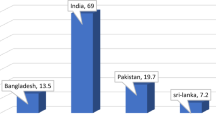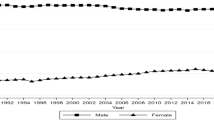Abstract
This paper presents new evidence regarding the effects of legalization on the training of immigrants who were granted legal status through the US Immigration Reform and Control Act (IRCA) of 1986. Our findings point to a large increase in the immigrants’ incidence of training relative to comparable groups of natives following legalization. While training gains are higher for males, wage gains are higher for females. We also show that an important part of these changes in labor market outcomes occurs through occupation changes by newly legalized immigrants.





Similar content being viewed by others
Notes
Other related studies of the USA and Europe include Reyneri (1998), Barcellos (2010), and Fasani (2014). Sampaio et al. (2013) argues the evidence on wage gains following legalization is not robust to a modest amount of correlation between unobserved immigrant characteristics and unobserved wage determinants.
See Gonzales 1997 for a review of the political evolution and the socioeconomic position of immigrants that followed IRCA.
Wages in the NLSY79 were censored above 1000 and below 0.5, which affected five observations in the NLSY sample, despite which a few very high values remain.
In the Appendix, we report the exact questions from the LPS and NLSY surveys that were used to construct the training indicator variables. In the Supplemental Material, available upon request, we show descriptive statistics for relevant dates, by sub-sample.
In the Supplemental Material, we show that our sample size is comparable with that reported in other papers that used the LPS and NLSY surveys.
The results of unconditional (without covariates) BA and DD estimates for all individuals, and by gender and skill level, are reported in Table 10 in the Appendix.
The decision to estimate the effect of interest by gender and skill level is formally validated performing Chow tests. The results of these tests are reported in the Supplemental Material.
9 Note that skill biased technical change, which here could be modeled as a higher α for skilled individuals, while not necessary for skilled workers to train more than unskilled workers, would make this result more likely.
10 These results could also reflect the outcome of a household decision process where primary earners men—choose careers with high skill acquisition content, while secondary earners women—choose careers with higher starting salaries. A phenomenon of this type was already identified by Cobb-Clark et al. (2005) in Australia.
The differences in observables in the pre-treatment period remain after we split the data by gender and skill level, as it can be seen in the Supplemental Material.
In the Appendix, we report the complete results of the DD estimates, including estimates for all covariates. Results for the other estimators (BA, CC, and MDD) are available upon request.
In the Appendix, we report the complete results of the DD estimates, including estimates for all covariates. Results for the other estimators (BA, CC, and MDD) are available upon request.
Similar results for BA and MDD nonlinear models are available upon request.
Results for estimates of covariates in nonlinear models are available upon request.
Similar results for BA and MDD nonlinear models are available upon request.
Results of the sensitivity analysis for wage and occupational quality by skill level are available upon request. In all regressions, differences in the estimated effects between unskilled and skilled workers are not statistically significant.
References
Abadie A (2005) Semiparametric difference-in-differences estimators. Rev Econ Stud 72(1):1–19
Amuedo-Dorantes C, Bansak C, Raphael S (2007) Gender differences in the labor market: impact of IRCAs amnesty provisions. Am Econ Rev 97(2):412–416
Athey S, Imbens GW (2006) Identification and inference in nonlinear difference-in-differences models. Econometrica 74:431–497
Baldacci E, Inglese L, Strozza S (1999) Determinants of foreign workers’ wages in two Italian regions with high illegal immigration. Labour 13(3):675–710
Barcellos S (2010) Legalization and economic status of immigrants. Rand Working Paper 754. Rand Corporation
Blundell R, Dias MC, Meghir C, Reenen JV (2004) Evaluating the employment impact of a mandatory job search program. J Eur Econ Assoc 2 (4):569–606
Borjas GJ, Tienda M (1993) The employment and sages of legalized immigrants. Int Migr Rev 27(4):712–747
Cobb-Clark D, Connolly MD, Worswick C (2005) Post-migration investments in education and job search: a family perspective. J Popul Econ 18(4):663–690
Cohen-Goldner S, Eckstein Z (2008) Labor mobility of immigrants: training experience, language, and opportunities. Int Econ Rev 49(3):837–872
Cohen-Goldner S, Eckstein Z (2010) Estimating the return to training and occupational experience: the case of female immigrants. J Econ 156(1):86–105
Epstein GS, Weiss A (2011) The why, when, and how of immigration amnesties. J Popul Econ 24(1):285–316
Fasani F (2014) Understanding the role of immigrants’ legal status: evidence from policy experiments. IZA discussion paper number 8576
Gonzalez Baker S (1997) The “Amnesty” aftermath: current policy issues stemming from the legalization programs of the 1986 immigration reform an control act. Int Migr Rev 31(1):5–27
Kaushal N (2006) Amnesty programs and the labor market outcomes of undocumented workers. J Hum Resour 41(3):631–647
Kossoudji SA, Cobb-Clark DA (2000) IRCA’s impact on the occupational concentration and mobility of newly-legalized Mexican men. J Labor Econ 13(1):81–98
Kossoudji SA, Cobb-Clark DA (2002) Coming out of the shadows: learning about legal status and wages from the legalized population. J Labor Econ 20(3):598–628
Levinson A (2005) The regularization of unauthorized migrants: literature survey and country case studies. COMPAS Report. Centre on Migration, Policy and Society, University of Oxford, Oxford
Méndez F, Sepúlveda F (2012) The cyclicality of skill acquisition: evidence from panel data. Am Econ J Macroecon 4(3):128–152
Pan Y (2012) The impact of legal status on immigrants’ earnings and human capital: evidence from the IRCA 1986. J Lab Res 33:119–142
Reyneri E (1998) The mass legalization of migrants in Italy: permanent or temporary emergence from the underground economy. South Eur Soc Polit 3(3):83–104
Rivera-Batiz FL (1999) Undocumented workers in the labor market: an analysis of the earnings of legal and illegal Mexican immigrants in the United States. J Popul Econ 12(1):91–116
Ruhs M (2007) Changing status, changing fortunes? The impact of acquiring EU status on the earnings of East European migrants to the UK. Centre on Migration, Policy and Society, University of Oxford, Oxford
Sampaio B, Ramos Sampaio G, Sampaio Y (2013) On estimating the effects of immigrant legalization: do U.S. agricultural workers really benefit? Am J Agric Econ 95(4):932–48
Villa JM (2011) DIFF: stata module to perform differences in differences estimation. Statistical software components. Boston College Department of Economics
Acknowledgments
We wish to thank Carolina Concha for expert research assistance. We also wish to thank three anonymous referees for their helpful suggestions. Facundo Sepúlveda acknowledges financial support from FONDECYT (Fondo Nacional de Desarrollo Científico y Tecnológico) project No 1151116. Nieves Valdés acknowledges financial support from FONDECYT (Fondo Nacional de Desarrollo Científico y Tecnológico) project No 11130058. Fabio Méndez acknowledges financial support in the form a Summer Research Grant from the Sellinger School of Business and Management at Loyola University Maryland. All errors are ours.
Author information
Authors and Affiliations
Corresponding author
Additional information
Responsible editor: Klaus F. Zimmermann
Electronic supplementary material
Below is the link to the electronic supplementary material.
Appendix
Appendix
1.1 Questions on training in LPS and NLSY79
LPS respondents are asked:
“Before you applied for temporary residence, did you ever attend a formal job training program in the United States? Please do not include any informal job training you received while you were working.”
“(Since you applied for temporary residence) Have you attended any formal job training program?”
NLSY79 respondents are asked:
“(Besides the training we’ve already talked about) Since (date of last interview), have you received training from any (other) source, such as the kinds of places listed on this card? For example, training in a business college, nurses program, an apprenticeship program, a vocational-technical institute, or any of these other kinds of sources?”
1.2 Tables
Rights and permissions
About this article
Cite this article
Méndez, F., Sepúlveda, F. & Valdés, N. Legalization and human capital accumulation. J Popul Econ 29, 721–756 (2016). https://doi.org/10.1007/s00148-016-0585-0
Received:
Accepted:
Published:
Issue Date:
DOI: https://doi.org/10.1007/s00148-016-0585-0




